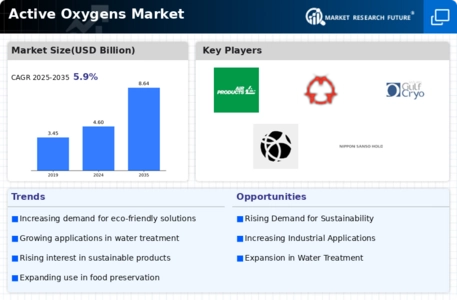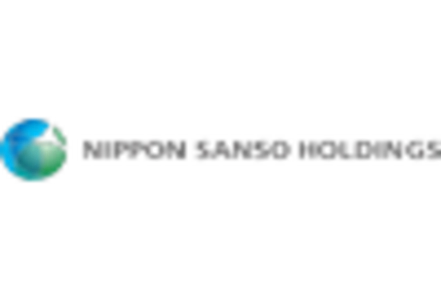-
EXECUTIVE SUMMARY
-
MARKET INTRODUCTION
-
Definition
-
Scope of the Study
- Research Objective
- Assumptions
- Limitations
-
RESEARCH METHODOLOGY
-
Overview
-
Data Mining
-
Secondary Research
-
Primary Research
- Primary Interviews
- Breakdown of Primary Respondents
-
and Information Gathering Process
-
Forecasting Model
-
Market Size Estimation
- Bottom-Up Approach
- Top-Down Approach
-
Data Triangulation
-
Validation
-
MARKET DYNAMICS
-
Overview
-
Drivers
-
Restraints
-
Opportunities
-
MARKET FACTOR ANALYSIS
-
Value Chain Analysis
-
Porter’s Five Forces Analysis
- Bargaining Power
- Threat of New Entrants
- Threat of Substitutes
- Intensity of Rivalry
-
of Suppliers
-
5.2.2.
-
Bargaining Power of Buyers
-
COVID-19 Impact Analysis
- Market Impact Analysis
- Regional Impact
- Opportunity and
-
Threat Analysis
-
6.
-
GLOBAL ACTIVE OXYGENS MARKET, BY FORM
-
Overview
-
Gaseous
-
Liquid
-
Solid
-
GLOBAL ACTIVE OXYGENS MARKET, BY APPLICATION
-
Overview
-
Pharmaceutical
-
Cosmetics
-
Mining and mineral
-
processing
-
7.5.
-
Automobiles
-
8.
-
GLOBAL ACTIVE OXYGENS MARKET, BY END-USE INDUSTRIES
-
Overview
-
Medical
-
Industrial
-
Scientific
-
GLOBAL ACTIVE OXYGENS MARKET, BY REGION
-
Overview
-
North America
- US
- Canada
-
Europe
- Germany
- France
- UK
- Italy
- Spain
- Rest of Europe
-
Asia-Pacific
- China
- India
- Japan
- South Korea
- Australia
- Rest of Asia-Pacific
-
Rest of the World
- Middle East
- Africa
- Latin America
-
COMPETITIVE LANDSCAPE
-
Overview
-
Competitive Analysis
-
Market Share Analysis
-
Major Growth Strategy in the Global Active
-
Oxygens Market,
-
10.5.
-
Competitive Benchmarking
-
Leading Players in Terms of Number of Developments in the Global
- New Product Launch/Service Deployment
- Merger &
- Sales & Operating Income, 2022
- Major Players R&D Expenditure. 2022
-
Active Oxygens Market,
-
10.7.
-
Key developments and Growth Strategies
-
Acquisitions
-
10.7.3.
-
Joint Ventures
-
10.8.
-
Major Players Financial Matrix
-
COMPANY PROFILES
-
Air Products Inc.
- Company Overview
- Financial Overview
- Products Offered
- Key Developments
- SWOT Analysis
- Key Strategies
-
Air Liquide
- Company Overview
- Financial Overview
- Products Offered
- Key Developments
- SWOT Analysis
- Key Strategies
-
Bhuruka Gases Limited
- Company Overview
- Financial Overview
- Products Offered
- Key Developments
- SWOT Analysis
- Key Strategies
-
Daesung Group
- Company Overview
- Financial Overview
- Products Offered
- Key Developments
- SWOT Analysis
- Key Strategies
-
Gulf Cryo
- Company Overview
- Financial Overview
- Products Offered
- Key Developments
- SWOT Analysis
- Key Strategies
-
Inox-Air Products
- Company Overview
- Financial Overview
- Products Offered
- Key Developments
- SWOT Analysis
- Key Strategies
-
Inc
-
11.6.1.
-
Company Overview
-
11.6.2.
-
Financial Overview
-
11.6.3.
-
Products Offered
-
11.6.4.
-
Key Developments
-
11.6.5.
-
SWOT Analysis
-
11.6.6.
-
Key Strategies
-
11.7.
-
KOATSU GAS KOGYO CO., LTD
-
LINDE PLC
- Company Overview
- Financial Overview
- Products Offered
- Key Developments
- SWOT Analysis
- Key Strategies
-
Matheson Tri-Gas, Inc
- Company Overview
- Financial Overview
- Products Offered
- Key Developments
- SWOT Analysis
- Key Strategies
-
Nippon Gases
- Company Overview
- Financial Overview
- Products Offered
- Key Developments
- SWOT Analysis
- Key Strategies
-
SHOWA DENKO K.K
- Company Overview
- Financial Overview
- Products Offered
- Key Developments
- SWOT Analysis
- Key Strategies
-
SOL Spa
- Company Overview
- Financial Overview
- Products Offered
- Key Developments
- SWOT Analysis
- Key Strategies
-
TAIYO NIPPON SANSO CORPORATION
- Company Overview
- Financial Overview
- Products Offered
- Key Developments
- SWOT Analysis
-
Yingde Gases Group
- Company Overview
- Financial Overview
- Products Offered
- Key Developments
- SWOT Analysis
- Key Strategies
-
APPENDIX
-
References
-
Related Reports
-
-
LIST OF TABLES
-
GLOBAL ACTIVE OXYGENS
-
MARKET, SYNOPSIS, 2018-2034
-
GLOBAL ACTIVE OXYGENS MARKET, ESTIMATES & FORECAST, 2018-2034
-
(USD BILLION)
-
TABLE
-
GLOBAL ACTIVE OXYGENS MARKET, BY FORM, 2018-2034 (USD BILLION)
-
GLOBAL ACTIVE OXYGENS
-
MARKET, BY APPLICATION, 2018-2034 (USD BILLION)
-
GLOBAL ACTIVE OXYGENS MARKET, BY END-USE
-
INDUSTRIES, 2018-2034 (USD BILLION)
-
NORTH AMERICA: ACTIVE OXYGENS MARKET, BY FORM, 2018-2034
-
(USD BILLION)
-
TABLE
-
NORTH AMERICA: ACTIVE OXYGENS MARKET, BY APPLICATION, 2018-2034 (USD BILLION)
-
NORTH
-
AMERICA: ACTIVE OXYGENS MARKET, BY END-USE INDUSTRIES, 2018-2034 (USD BILLION)
-
US: ACTIVE OXYGENS
-
MARKET, BY FORM, 2018-2034 (USD BILLION)
-
US: ACTIVE OXYGENS MARKET, BY APPLICATION, 2018-2034
-
(USD BILLION)
-
TABLE
-
US: ACTIVE OXYGENS MARKET, BY END-USE INDUSTRIES, 2018-2034 (USD BILLION)
-
CANADA: ACTIVE
-
OXYGENS MARKET, BY FORM, 2018-2034 (USD BILLION)
-
CANADA: ACTIVE OXYGENS MARKET, BY APPLICATION,
-
CANADA: ACTIVE OXYGENS MARKET, BY END-USE INDUSTRIES, 2018-2034
-
(USD BILLION)
-
TABLE
-
EUROPE: ACTIVE OXYGENS MARKET, BY FORM, 2018-2034 (USD BILLION)
-
EUROPE: ACTIVE OXYGENS
-
MARKET, BY APPLICATION, 2018-2034 (USD BILLION)
-
EUROPE: ACTIVE OXYGENS MARKET, BY END-USE
-
INDUSTRIES, 2018-2034 (USD BILLION)
-
GERMANY: ACTIVE OXYGENS MARKET, BY FORM, 2018-2034
-
(USD BILLION)
-
TABLE
-
GERMANY: ACTIVE OXYGENS MARKET, BY APPLICATION, 2018-2034 (USD BILLION)
-
GERMANY: ACTIVE
-
OXYGENS MARKET, BY END-USE INDUSTRIES, 2018-2034 (USD BILLION)
-
FRANCE: ACTIVE OXYGENS
-
MARKET, BY FORM, 2018-2034 (USD BILLION)
-
FRANCE: ACTIVE OXYGENS MARKET, BY APPLICATION, 2018-2034
-
(USD BILLION)
-
TABLE
-
FRANCE: ACTIVE OXYGENS MARKET, BY END-USE INDUSTRIES, 2018-2034 (USD BILLION)
-
ITALY: ACTIVE
-
OXYGENS MARKET, BY FORM, 2018-2034 (USD BILLION)
-
ITALY: ACTIVE OXYGENS MARKET, BY APPLICATION,
-
ITALY: ACTIVE OXYGENS MARKET, BY END-USE INDUSTRIES, 2018-2034
-
(USD BILLION)
-
TABLE
-
SPAIN: ACTIVE OXYGENS MARKET, BY FORM, 2018-2034 (USD BILLION)
-
SPAIN: ACTIVE OXYGENS
-
MARKET, BY APPLICATION, 2018-2034 (USD BILLION)
-
SPAIN: ACTIVE OXYGENS MARKET, BY END-USE
-
INDUSTRIES, 2018-2034 (USD BILLION)
-
UK: ACTIVE OXYGENS MARKET, BY FORM, 2018-2034 (USD
-
BILLION)
-
TABLE
-
UK: ACTIVE OXYGENS MARKET, BY APPLICATION, 2018-2034 (USD BILLION)
-
UK: ACTIVE OXYGENS
-
MARKET, BY END-USE INDUSTRIES, 2018-2034 (USD BILLION)
-
REST OF EUROPE: ACTIVE OXYGENS MARKET, BY
-
FORM, 2018-2034 (USD BILLION)
-
REST OF EUROPE: ACTIVE OXYGENS MARKET, BY APPLICATION, 2018-2034
-
(USD BILLION)
-
TABLE
-
REST OF EUROPE: ACTIVE OXYGENS MARKET, BY END-USE INDUSTRIES, 2018-2034 (USD
-
BILLION)
-
TABLE
-
ASIA-PACIFIC: ACTIVE OXYGENS MARKET, BY FORM, 2018-2034 (USD BILLION)
-
ASIA-PACIFIC:
-
ACTIVE OXYGENS MARKET, BY APPLICATION, 2018-2034 (USD BILLION)
-
ASIA-PACIFIC: ACTIVE
-
OXYGENS MARKET, BY END-USE INDUSTRIES, 2018-2034 (USD BILLION)
-
JAPAN: ACTIVE OXYGENS
-
MARKET, BY FORM, 2018-2034 (USD BILLION)
-
JAPAN: ACTIVE OXYGENS MARKET, BY APPLICATION, 2018-2034
-
(USD BILLION)
-
TABLE
-
JAPAN: ACTIVE OXYGENS MARKET, BY END-USE INDUSTRIES, 2018-2034 (USD BILLION)
-
CHINA:
-
ACTIVE OXYGENS MARKET, BY FORM, 2018-2034 (USD BILLION)
-
CHINA: ACTIVE OXYGENS MARKET, BY APPLICATION,
-
CHINA: ACTIVE OXYGENS MARKET, BY END-USE INDUSTRIES, 2018-2034
-
(USD BILLION)
-
TABLE
-
INDIA: ACTIVE OXYGENS MARKET, BY FORM, 2018-2034 (USD BILLION)
-
INDIA: ACTIVE OXYGENS
-
MARKET, BY APPLICATION, 2018-2034 (USD BILLION)
-
INDIA: ACTIVE OXYGENS MARKET, BY END-USE
-
INDUSTRIES, 2018-2034 (USD BILLION)
-
AUSTRALIA: ACTIVE OXYGENS MARKET, BY FORM, 2018-2034
-
(USD BILLION)
-
TABLE
-
AUSTRALIA: ACTIVE OXYGENS MARKET, BY APPLICATION, 2018-2034 (USD BILLION)
-
AUSTRALIA: ACTIVE
-
OXYGENS MARKET, BY END-USE INDUSTRIES, 2018-2034 (USD BILLION)
-
SOUTH KOREA: ACTIVE
-
OXYGENS MARKET, BY FORM, 2018-2034 (USD BILLION)
-
SOUTH KOREA: ACTIVE OXYGENS MARKET, BY APPLICATION,
-
SOUTH KOREA: ACTIVE OXYGENS MARKET, BY END-USE INDUSTRIES,
-
REST OF ASIA-PACIFIC: ACTIVE OXYGENS MARKET, BY FORM, 2018-2034
-
(USD BILLION)
-
TABLE
-
REST OF ASIA-PACIFIC: ACTIVE OXYGENS MARKET, BY APPLICATION, 2018-2034 (USD BILLION)
-
REST
-
OF ASIA-PACIFIC: ACTIVE OXYGENS MARKET, BY END-USE INDUSTRIES, 2018-2034 (USD BILLION)
-
REST
-
OF THE WORLD: ACTIVE OXYGENS MARKET, BY FORM, 2018-2034 (USD BILLION)
-
REST OF THE
-
WORLD: ACTIVE OXYGENS MARKET, BY APPLICATION, 2018-2034 (USD BILLION)
-
REST OF THE
-
WORLD: ACTIVE OXYGENS MARKET, BY END-USE INDUSTRIES, 2018-2034 (USD BILLION)
-
MIDDLE EAST:
-
ACTIVE OXYGENS MARKET, BY FORM, 2018-2034 (USD BILLION)
-
MIDDLE EAST: ACTIVE OXYGENS MARKET, BY APPLICATION,
-
MIDDLE EAST: ACTIVE OXYGENS MARKET, BY END-USE INDUSTRIES,
-
AFRICA: ACTIVE OXYGENS MARKET, BY FORM, 2018-2034 (USD BILLION)
-
AFRICA: ACTIVE
-
OXYGENS MARKET, BY APPLICATION, 2018-2034 (USD BILLION)
-
AFRICA: ACTIVE OXYGENS MARKET, BY END-USE
-
INDUSTRIES, 2018-2034 (USD BILLION)
-
LATIN AMERICA: ACTIVE OXYGENS MARKET, BY FORM,
-
LATIN AMERICA: ACTIVE OXYGENS MARKET, BY APPLICATION, 2018-2034
-
(USD BILLION)
-
TABLE
-
LATIN AMERICA: ACTIVE OXYGENS MARKET, BY END-USE INDUSTRIES, 2018-2034 (USD BILLION)
-
LIST OF FIGURES
-
RESEARCH PROCESS
-
MARKET STRUCTURE
-
FOR THE GLOBAL ACTIVE OXYGENS MARKET
-
MARKET DYNAMICS FOR THE GLOBAL ACTIVE OXYGENS MARKET
-
GLOBAL ACTIVE
-
OXYGENS MARKET, SHARE (%), BY FORM, 2022
-
GLOBAL ACTIVE OXYGENS MARKET, SHARE (%), BY APPLICATION,
-
FIGURE
-
GLOBAL ACTIVE OXYGENS MARKET, SHARE (%), BY END-USE INDUSTRIES, 2022
-
GLOBAL ACTIVE
-
OXYGENS MARKET, SHARE (%), BY REGION, 2022
-
NORTH AMERICA: ACTIVE OXYGENS MARKET, SHARE
-
(%), BY REGION, 2022
-
FIGURE
-
EUROPE: ACTIVE OXYGENS MARKET, SHARE (%), BY REGION, 2022
-
ASIA-PACIFIC: ACTIVE OXYGENS MARKET, SHARE
-
(%), BY REGION, 2022
-
FIGURE
-
REST OF THE WORLD: ACTIVE OXYGENS MARKET, SHARE (%), BY REGION, 2022
-
GLOBAL ACTIVE
-
OXYGENS MARKET: COMPANY SHARE ANALYSIS, 2022 (%)
-
AIR PRODUCTS INC.: FINANCIAL OVERVIEW SNAPSHOT
-
AIR PRODUCTS
-
INC.: SWOT ANALYSIS
-
FIGURE
-
AIR LIQUIDE: FINANCIAL OVERVIEW SNAPSHOT
-
AIR LIQUIDE: SWOT ANALYSIS
-
BHURUKA GASES LIMITED:
-
FINANCIAL OVERVIEW SNAPSHOT
-
BHURUKA GASES LIMITED: SWOT ANALYSIS
-
DAESUNG GROUP: FINANCIAL OVERVIEW SNAPSHOT
-
DAESUNG GROUP:
-
SWOT ANALYSIS
-
FIGURE
-
GULF CRYO.: FINANCIAL OVERVIEW SNAPSHOT
-
GULF CRYO.: SWOT ANALYSIS
-
INOX-AIR PRODUCTS INC:
-
FINANCIAL OVERVIEW SNAPSHOT
-
INOX-AIR PRODUCTS INC: SWOT ANALYSIS
-
KOATSU GAS KOGYO CO., LTD: FINANCIAL OVERVIEW
-
SNAPSHOT
-
FIGURE
-
KOATSU GAS KOGYO CO., LTD: SWOT ANALYSIS
-
LINDE PLC: FINANCIAL OVERVIEW SNAPSHOT
-
LINDE PLC:
-
SWOT ANALYSIS
-
FIGURE
-
MATHESON TRI-GAS, INC: FINANCIAL OVERVIEW SNAPSHOT
-
MATHESON TRI-GAS, INC: SWOT ANALYSIS
-
NIPPON GASES:
-
FINANCIAL OVERVIEW SNAPSHOT
-
NIPPON GASES: SWOT ANALYSIS
-
SHOWA DENKO K.K: FINANCIAL OVERVIEW SNAPSHOT
-
FIGURE 34
-
SHOWA DENKO K.K: SWOT ANALYSIS
-
SOL SPA: FINANCIAL OVERVIEW SNAPSHOT
-
SOL SPA: SWOT ANALYSIS
-
TAIYO NIPPON SANSO
-
CORPORATION: FINANCIAL OVERVIEW SNAPSHOT
-
TAIYO NIPPON SANSO CORPORATION: SWOT ANALYSIS
-
YINGDE GASES
-
GROUP: FINANCIAL OVERVIEW SNAPSHOT
-
YINGDE GASES GROUP: SWOT ANALYSIS










Leave a Comment